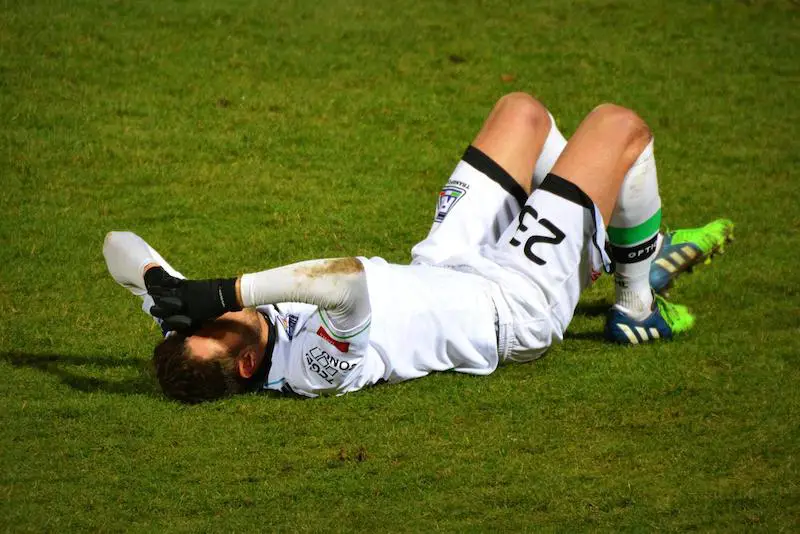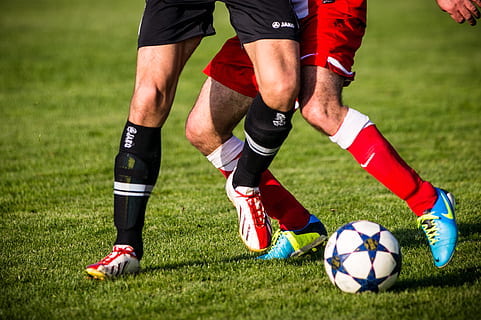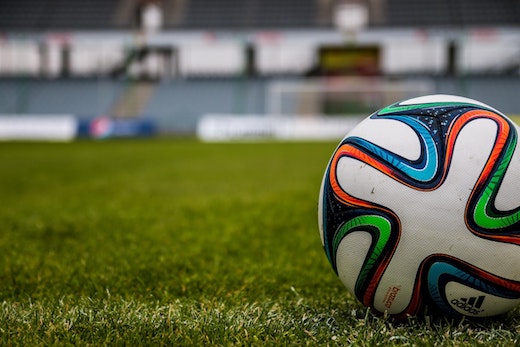Your Guide
 Alex Waite
Alex Waite
- Slow Down, Take Deep Breaths, Apply Pressure and Keep Upright if You Develop a Side Stitch.
- Trying to Prevent a Stitch by Taking Precautions Before a Match. This Is Easier Than Managing a Stitch.
- There Are Two Theories About Why Stitches Occur When Athletes Exercise.
If you develop a stitch whilst playing soccer, take DEEP BREATHS, apply pressure to the area and KEEP UPRIGHT.
These are some of the most important tips. But, the main thing to do is to KEEP CALM and try to get your BREATHING PATTERN NORMAL.

Recognizing what a stitch is is important in helping to eliminate it.
I have seen soccer players think they are in severe danger of having heart palpitations when in fact, they just have a stitch.
However, if you are in bad discomfort, go down and ask to be substituted off the pitch.
According to advanced practice nurse Deborah Weatherspoon, Ph.D., a stitch is “pain felt on either side of your abdomen“.
It’s more commonly reported on THE RIGHT SIDE.
Symptoms may range from CRAMPING or a DULL ACHE to a pulling sensation or a sharp, stabbing pain.”
Ultimately, the severity of stitches varies.
As a teenage soccer player, I could eat half a meal an hour before a game, get a stitch and run it off.
However, as I continued playing at a higher pace and standard of soccer, stitches were harder to shake off.
This required some adaptations and awareness of how to continue playing whilst trying to subside a pain in my side.
More often than not, players can get rid of stitches whilst remaining on the pitch. I
n this article, we outline some of the top tips to help get rid of a stitch when running down the pitch.
We also provide advice on how to prevent a stitch from occurring.
What to Do When You Get a Stitch on the Soccer Pitch?
Firstly, it is important NOT TO PANIC.
Some players OVERREACT and fear the worst when they have an injury.
However, this is COUNTER PRODUCTIVE and can cause unnecessary concern and panic.
When people become anxious, their breathing pace increases, and their heart rate rises.
This will not help to get rid of any injury quicker, let alone a stitch.
Once you recognize it’s a stitch you are experiencing, follow our advice below on how to help subside the discomfort.
1) Take Deep Breaths
Deep, controlled breathing pushes down on the diaphragm (the affected area during a side stitch).
By regulating breathing and TAKING LONGER INHALES, players can relieve some of the pressure.
In soccer matches, this can be difficult as the fast pace of the game leads to faster heart rates and faster breathing.
In the past, I have seen players sit down and take their time once they have a stitch rather than try to keep pushing through and running a stitch off.
This is a good strategy as it allows the player to fully recover rather than make the issue worse.
2) Apply Pressure to the Area Affected
PRESSING DOWN GENTLY on the SIDE where the stitch is happening can also help to manually relieve the pressure.
Again, this is not always a practical mid-match.
However, do not be afraid to go down with an injury rather than try to push through the pain.
3) Stretch
Gently moving the affected side during a stitch can ease the pressure. For instance, if the pain is around the left side, try arching your left hand over your head towards your right side. You should feel a stretch in your left abdomen and around the ribs. Continue this for a few minutes and the pain can ease.
4) Keep Upright and Keep Moving Gently
If the stitch is uncomfortable, come off the pitch, keep standing and talk a gentle stroll away from the pitch.
Whilst doing this, concentrate on DEEP BREATHS and apply some pressure to the area.
Coming off the pitch and taking time to calmly regain composure will help to speed up the recovery rather than forcing through the pain.
In my experience, as is the case with any injury, playing through the pain almost always has long-term effects.
After heavy stitches whilst playing, I have seen players continually holding their side for hours after a match.
Others have no appetite and some can’t even handle drinking water because of the pressure on their side.
Sometimes, thinking about your health is more important than the pride of staying on the pitch.
How to Prevent a Stitch When Playing Soccer?
Stitches develop for numerous reasons.
These include eating too soon before:
- Exercise
- Eating Too Quickly
- Being Dehydrated
- Over-Exerting Too Quickly and
- Poor Posture
Ultimately, preventing a stitch from developing is easier, more manageable, and less painful than dealing with the pain during a match.
Here are some tips to try and prevent a soccer stitch.
i) When and What Are You Eating?
Regularly, I see players eat RIDICULOUS MEALS before matches.
I have seen players DEVOUR a sandwich, chips, a sausage roll, and even a FULL English BREAKFAST.
Sometimes, this would be an hour or less before a match!
Unsurprisingly, they would head out onto the pitch only to be back in the changing room 20 minutes later with a stitch.
Heavy food anytime leading up to a match is a BIG NO.
Avoid food that is hard to digest and swap this for MORE HEALTHY, LIGHT OPTIONS.
Also, consider a routine diet around your soccer activity. Christopher R. Mohr, Ph.D. has several helpful tips on what and when to eat for athletes of all abilities in his sports nutrition article.
Usually, when I have an early morning match, I would get up early, have a light breakfast, then keep hydrated until the match.
I also ate fruit, such as oranges and bananas just before or during a game to keep my GLUCOSE LEVELS HIGH.
This worked for me, but each player will have their routines and habits to help improve performance and prevent those pesky stitches.
ii) Keep Hydrated
Being hydrated during a soccer match is essential to performance…
..But, drinking the right amount of water is also key as too much liquid can lead to bloating and a side stitch.
In the hot summer months during pre-season training, I and my teammates were always encouraged to DRINK WATER.
Scheduled breaks would help to keep topping up water levels.
However, when playing soccer in 30-degree heat, you often drink more than your body can handle.
This would lead to uncomfortable feelings in the stomach and eventually create cramps in the abdomen and side.
Therefore, think about topping up with regular sips rather than drinking liters and liters of water to ward off those unwanted stitches.
iii) Don’t Skip the Warm-up
In soccer, players need to combine static and mobile warm-ups before matches and practice.
Static warm-ups are based on stretching the muscles.
Mobile warm-ups help to get oxygen moving through the body through gentle jogging, for example.
These activities prepare your body for more vigorous activities during high-intensity matches and training.
But, they can also prevent side stitches.
In particular, stretching the muscles around your diaphragm can help to prevent a stitch.
iv) Pace Yourself
Getting caught up in the heat of a match is a BIG MENTAL CHALLENGE for soccer players at all levels.
I remember playing in important cup matches, League Title Deciders, Relegation Dogfights, and Simple Local Rivalries.
In these instances, going on to the pitch with a level head is challenging, but it is essential.
So many times, especially when coaching youth teams, I have seen players become too relaxed with their warm-up then try to start the match at 100% performance.
Simply put, this is impossible for any soccer player, and taking time to get into the flow of a match is important.
It also helps to prevent overexertion and injury, including stitches.
Your body will not be ready to go from near static to full mobility in an instant.
What Is a Stitch and How Is It Caused?
According to health writer Jane Chertoff, in an article peer-reviewed by Dr. Deborah Weatherspoon there are two theories about how side stitches occur.
However, the exact cause is still unknown.
- Blood in Diaphragm: Too much blood can move to the diaphragm causing pain and strain in the side.
- Lining of Abdominal and Pelvic Cavity: Irritation and friction of this area can happen during intense physical activity. As a result, this can cause more specific, local pains, like in the shoulder.


